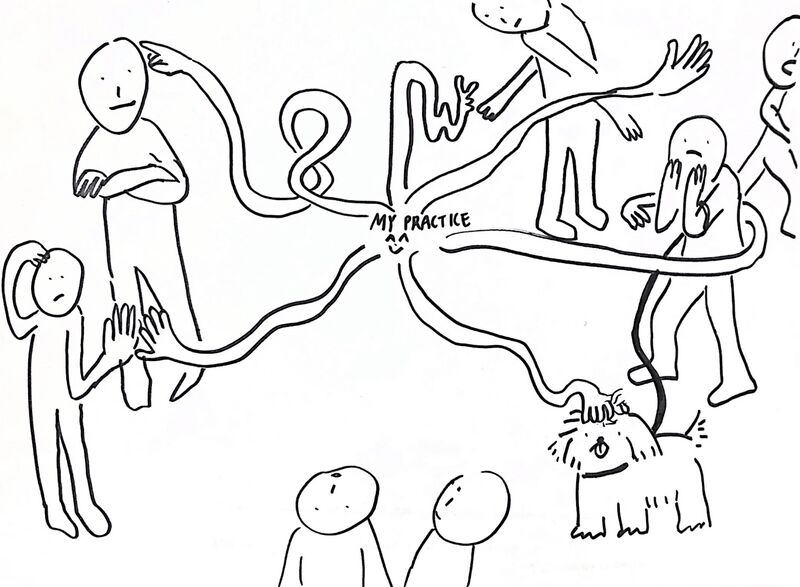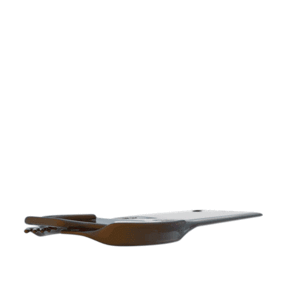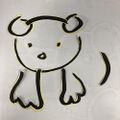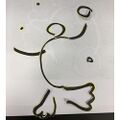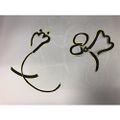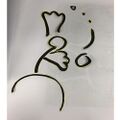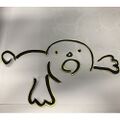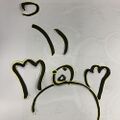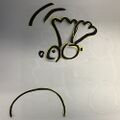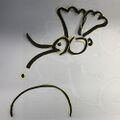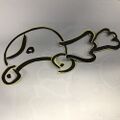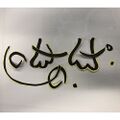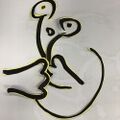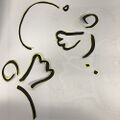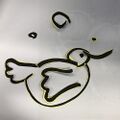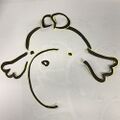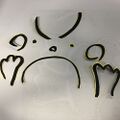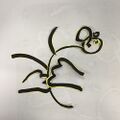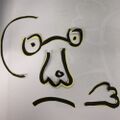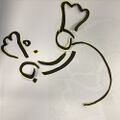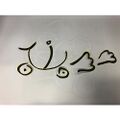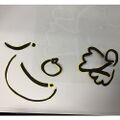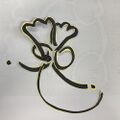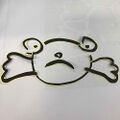User:Chae0: Difference between revisions
| Line 74: | Line 74: | ||
| blowing - feather || Example || Example || Example || Example | | blowing - feather || Example || Example || Example || Example | ||
|- | |- | ||
| child drawing | | scanned child drawing sticker in telegram || Example || Example || high on noise. 컴퓨터 화면에서 찌직거리는 선의 느낌을 볼 수 있는게 || Example | ||
|- | |- | ||
| licking - the tip of the envelope || Example || Example || Example || Example | | licking - the tip of the envelope || Example || Example || Example || Example | ||
| Line 86: | Line 86: | ||
| margin / notes || Example || Example || Example || Example | | margin / notes || Example || Example || Example || Example | ||
|- | |- | ||
| pockets || | | pockets || pockets attatched to apparllel || Example || Example || tiny, small - hidden - soft - warmth | ||
|- | |- | ||
| whisper - string telephone || with a string telephone technique, you can talk with someone far. Also if you put an audio player in the telephone, one can hear it with some || Example || Example || Example | | whisper - string telephone || with a string telephone technique, you can talk with someone far. Also if you put an audio player in the telephone, one can hear it with some || Example || Example || Example | ||
|- | |||
| scanned book || Example || Example || high on noise || Example | |||
|- | |||
| petting - raspberry || Example || Example || Example || Example | |||
|- | |||
| Example || Example || Example || Example || Example | |||
|- | |- | ||
| Example || Example || Example || Example || Example | | Example || Example || Example || Example || Example | ||
Revision as of 16:43, 23 January 2023
hello ✋ I am Chaeyoung Kim
Chaeyoung Kim (she/her) is an interdisciplinary artist encompassing video, installation, performance and an art educator based in Seoul and Rotterdam. Her work draws on the aesthetics of cuteness such as bright colors, wobbly movements, high-pitched sounds to instigate ‘cute affects’ and encourage social interaction. Her extensive work experience as an art educator has made her aware of how curriculum content and workshops can be useful tools for positively impacting the local community.
website
kimchaeyoung.com (I did not pay for the domain so it's down atm)
self-portrait
During the self-study week, Nor organized the workshop called 'Collaboration, Conflict, Consent workshop'. During the workshop, we were asked to make a self-portrait about what excites us and what scares us. ʕʘ‿ʘʔ Also, the drawing underneath is an illustration of how I imagine my practice is or do to people.
Padliography (Thank you Kamo)
XPUB2 Log
semester 4
Form tag / FLASK / API / Invitation / sharing Sharing what? The purpose of the sharing and inviting others? ETC / list / enumerate: to name things one after another in a list / litless(힘이 없는, 무기력한-> 리스트 없음이 무기력한, 힘이 없는이라는 뜻이라는게 너무 웃기고 재미있어-> 리스트를 만들기 좋아하는 나.. 이것에 대한 코멘터리일 수 있을까?) / web-to-print / read between the lines, between the lines / line - draw the line 선 긋다. / drawing and writing, 네이버 사전에서 단어 글자를 그릴 수 있는 부분이 있는 것. / thin air / 일기장에 적었던 무거운 공기, 적대적 공기, 말할 수 없는 어떤 분위기 - pressure - 바람 / Dear Science and Other Stories, FOOTNOTES(BOOKS AND PAPERS SCATTERED ABOUT THE FLOOR) / affect (1. 영향을 미치다, 2. 사람이나 신체부위에 발생하다, 침범하다, 병이 나게 하다. 3. 강한 정서적 충격을 주다. 깊은 슬픔을 유발하다 4. 감정이나 생각을 가장하다 꾸미다)
semester 5
semester 5 - chae research log
semester 6
Special Issue Log
SI 16 - Vernacular Language Processing
- ETC Portal to Contamination (Final Endpoint)
- etc_Filter / Negative Space / Starting Point (Research Log)
- SI 16 - Vernacular Language Processing (Research log for overall semester)
SI 17 - Productive Play
- SI 17 - Productive Play (Research Log)
- https://issue.xpub.nl/17/index.html (SI 17 Main Webpage)
- Fage Not Pound (Documentation of the launch of SI17)
- Karaoke_reading (Group Contribution, Can Gaming Make A Better World?)
- https://media.xpub.nl/2022/SI17/karaoke-Final.mp4 (SI17, Can Gaming Make A Better World?)
SI 18 - Radio Implicancies
- SI 18 - Radio Implicancies - Chae's research log
- Critical and Intimate Evaluation of Crunchiness - with Erica Grrrrrr
- Writing Weekly - with Kimberley
List of intimacy/storytelling
| title | description | reference/image | value: closeness-noise/density-feeling | Tags (intimate story / intimate technology etc) |
|---|---|---|---|---|
| magical button | a workshop outcome with raphael | https://hub.xpub.nl/soupboat/constr/magical-button/ | Example | mamang / web / drawing |
| lost stories | For the 3rd public moment, I did a performance to read the letter I wrote to Mamang, and then invited people to | Example | Example | tiny - intimate story and medium |
| smart textile | if you press the soft button, the light will be up | Example | Example | Example |
| whispering - bread | Example | Example | the bread was super interesting because it has a really nice acoustic effect. I shared the story of the ugly side of me which was quite nice | food - soft and squishy - intimate story and medium |
| whispering - computer | during the Monday morning sesh, for Miri, I whispered to a computer | Example | Example | whisper / quick / hardware(computer-headphone-rolled paper) / software(jitsi) / rolled paper |
| qrcode butterfly | Example | Example | Example | Example |
| cute laser beam | Example | Example | Example | Example |
| tree-like-headphones | Example | Example | Example | Example |
| velcro | Example | Example | Example | Example |
| svg drawing pad | Example | Example | Example | Example |
| blowing - candle | Example | Example | Example | Example |
| blowing - feather | Example | Example | Example | Example |
| scanned child drawing sticker in telegram | Example | Example | high on noise. 컴퓨터 화면에서 찌직거리는 선의 느낌을 볼 수 있는게 | Example |
| licking - the tip of the envelope | Example | Example | Example | Example |
| licking - the stamp | Example | Example | Example | Example |
| fluffy - socks | Example | example | Example | Example |
| artificial tears | Example | https://en.wikipedia.org/wiki/Artificial_tears | Example | Example |
| margin / notes | Example | Example | Example | Example |
| pockets | pockets attatched to apparllel | Example | Example | tiny, small - hidden - soft - warmth |
| whisper - string telephone | with a string telephone technique, you can talk with someone far. Also if you put an audio player in the telephone, one can hear it with some | Example | Example | Example |
| scanned book | Example | Example | high on noise | Example |
| petting - raspberry | Example | Example | Example | Example |
| Example | Example | Example | Example | Example |
| Example | Example | Example | Example | Example |
| Example | Example | Example | Example | Example |
| Example | Example | Example | Example | Example |
Reading List
- Minor Feelings by Cathy Park Hong
- Queer Phenomenology: Orientations, Objects, Others by Sara Ahmed
- The Promise of Happiness by Sara Ahmed
행복은 우리와 가까운 영역, 우리 주변을 형성하고 있는 세계를 친숙한 것들의 세계로 만드는 데 결정적 역할을 한다. 우리에게 쾌락을 주는 대상들은 우리의 신체적 지평 안에 둥지를 튼다. 우리가 좋아하는 것들likes을 갖게 된다는 것은 우리가 무엇과 같은지 like를 확립하는 일이다. 신체적 지평이란 좋아하는 것들의 지평이다. "우리가 좋아하는 것들"을 가진다는 건 어떤 것들이 우리 주변에 모인다는 뜻이다. 물론, 우리는 새로운 것들과 마주치기도 한다. 새로운 것들에 개방적이라는 것은 우리가 그것들을 우리와 근접한 영역으로 흡수하는 데 개방적이란 뜻이다. 흡수할지 말지는 우리가 마주친 그것을 좋아하느냐에 달려 있다. 좋아하지 않는 것들로부터 우리는 거리를 둔다. 거리두기를 통해 우리는 우리 지평의 가장자리를 확립한다. [사라 아메드 행복의 약속: 불행한 자들을 위한 문화비평, 1장]
- The Aesthetics and Affects of Cuteness edited by Edited ByJoshua Paul Dale, Joyce Goggin, Julia Leyda, Anthony McIntyre, Diane Negra
- Dear Science by Katherine McKittrick
Wonder
(...)Dear Science argues that black people have always used interdisciplinary methodologies to explain, explore, and story the world, becuase thinking and writing and imagining across a range of texts, disciplines, histories, and genres unselttles suffocating and dismal and insular racial logics. By employing interdisciplinary methodologies and living interdisciplinary worlds, black people bring together various sources and texts and narratives to challenge racism. Or, black people bring together various sources and texts and narratives not to capture something or someone, but to question the analytical work of capturing, and the desire to capture, something or someone. (...) Within black studies and anticolonial studies, one can observe an ongoing method of gathering multifariously textured tales, narratives, fictions, whispers, songs, grooves. The texture offer one way to challenge the primacy of evidentiary and insular normalcies, because they are allegedly incongruous. In assembling ideas that are seemingly disconnected and uneven (the seabird and the epilogue, the song and the soil, the punch clock and the ecosystem, the streetlight and the kick-on-beat), the logic of knoeing-to-prove is unsustainable because incongruity appears to be offering atypical thinking. Yet curioisity thrives. (...) Also, assembling ideas that are seemingly connected () fuse and break apart how we know, necause we seek out continuities and ruptures. And curiosity thrives. (...) What is meaningful, then, are the ways in which black people are interdisciplinary actors, continually entangling and disentangling varying narratives and tempos and hues that, together, invent and reinvent knowledge.
FOOTNOTES
Black studies engenders, shares, and demands diasporic literacy; black studies theorizes black liberation not through categories (identity) but from the perspective of struggle (struggle is entangled with identities-places-embodiments-infrastructures-narratives-feeling).
THE SMALLEST CELL REMEMBERS A SOUND
If we are committed to anticolonial thought, our starting point must be one of disobedient relationality that always questions, and thus is not beholden to, normative academic logics.(...)The project of making discipline overwhelmingly only gives us two options for the study of black people--to describe racism and resist racism; these options rarely have any noise or curiosity or questions about black life interrupting them. (...) Method-making is the generating and gathering of ideas--across-with0outside-within-against normative disciplines--that seek out liberation within our present system of knowledge. The goal is not to find liberation, but to seek it out.
SOMETHING THAT EXCEEDS ALL EFFORTS TO DEFINITIVELY PIN IT DOWN
(...)The question of stories and storytelling illuminate the method of collaboration. I learned from working with her. I learned from her that sharing stories engenders creative rigorous radical theory. Wait. I learned from her that sharing stories is creative rigorous radical theory. The act of sharing stories is the theory and the methodology. The process is difficult to make sense of in terms of the process and praxis of collaboration as affective possibility. Every time we speak on the telephone, I have my pen in hand, but I do not always use it. We share ideas, and stories, and our histories, and part of this collaboration was her generously sharing ideas that I wrote down because I believed them with all my heart. And lucky for me, she believed me too. (We must believe each other; we must believe the stories we tell one another.) I guess what I am trying to write but cannot pinpoint is that the collaborative aspects of the work allowed us to share ideas in ways that I did not anticipate. The project is, then, not solely text; it is the unpublishable work of conversing over several years and continuing that conversation. I did not expect to be this patient. The conversation is forever and it is forever rewound very fast and then replayed; "The friendship itself, a form of life that cannot be totally capitalized on and is therefore slightly in excess of work as we know it.... Working in friendship could be a way to work outside of productivity demands."
FAILURE(MY HEAD WAS FULL OF <ISTY FUMES OF DOUBT)
(...)To put it simply, solving crimes often involves surveying and marking black and/or impoverished geographies and claiming that this is not profiling because places, rather than people, are being targeted. In other words, social problems are resolved through producing calculations, equations, and problem-solving operations; these problems (black people) are translated into cartographically itemized racial codes. Part of our task, then, is to notice how algorithms have a place and take place and produce place and how blackness--where we know from--understands and reorders these geographies. I also focus on geography to dislodge crude identity politics, to cast the net beyond the individual and to emphasize that where we know from--rather than what we already know about seemingly authentic selves--is a more generous and difficult political project that takes into account interhuman geographies. (...) With this in mind, I suture a black sense of place to these mathematics and problem-solving practices in order to unthink the violence that often accompanies the production of space. (...) The work and process of the coding conceals a long biocentric statistical history that continues to define "traits"--out genetic characteristics--as variables. A variable is a symbol that represents a quantity in a mathematical expression. What unfolds are measurable numbers--often abstracted from human input--calculating resolutions that we care about. /n If we understand algorithms in this vein, we can begin to tease out how numbers and mathematical equations are tied to a biocentric system if knowledge. What becomes increasingly clear, then, is not simply that the results and answers racist (e.g., your traits mathematically result in your incarceration), but that the work of administrating algorithms (e.g., what we do to solve the problems that we care about) requires biocentric methods and methodologies that can only produce dehumanizing mathematical results.(...)What comes into clear view, then, is not simply the racist result but the administrative and methodological steps that require racism before they begin to work through and towards the problem. (...) Geography matters because it functions to illuminate how algorithmic answers to our problems--what we care about--are embedded in place. Interestingly, the more we research these connections between geography and algorithms, the more we notice how the former, geography, is racially codified. Predictive algorithms are not only imitating a racist system, they are refusing an already refused black humanity by marking black geographies predictably criminal. (...) Part of our intellectual task, then, is to work out how different kinds and types of texts, voices, and geographies relate to each other and open up unexpected and surprising ways to talk about liberation, knowledge, and history, race, gender, narrative, and blackness. [이 챕터 특히 딸꾹질 / 그리고 phonetree에 대한 수피와의 아이디어랑 관련되어 있음을 강하게 느껴. 왜 그렇게 느끼는지 정리해서 적어둘것 2022.08.01]
- https://us.macmillan.com/books/9781250796516/grime (Jian's recommendation, dystopian, brilliant book)
- Writing Down The Bones by Natalie Goldberg
- Ngai S. (2007). Ugly feelings. Cambridge, Massachusetts Etc.: Harvard University Press.
- Wendy Chen
- Dictee, Teresa Hakyung Cha
- Eros in the library
- Xpub thesis
- Byron, P. (2022). Digital Media, Friendship and Cultures of Care. Routledge Research in Gender, Sexuality, and Media.
- Ahmed, S. (2004). The Cultural Politics of Emotion. New York: Routledge Taylor & Francis Group.
- Ahmed, S. (2006). Queer phenomenology : orientations, objects, others. Durham: Duke University Press.
- Bhanu Kapil Rider (2001). The Vertical Interrogation of Strangers. Kelsey Street Press.
- Bridle, J. (2022). Ways of being beyond human intelligence. London Allen Lane, An Imprint Of Penguin Books.
- 재난 시대의 정동 - 애동의 가능성과 불가능성, 문강형준
앞에서 얘기한 세월호 참사의 회국인 희생자들에 대한 공적 애도의 부재는 첫번째 한계와 맞닿아 있다. '한국인'이 아니기에 한국인으로부터 애도되지 못하는, 죽어서까지 '비가시적' 존재로 남게 되는 외국인 희생자들은 여전히 세월호 애도 국면의 한계다.희생자의 '낭만화' 역시 반복된다. 죽은 고등학생 하나하나를 '기억'하며 박재동 화백의 그림과 함께 이들의 짧은 생을 기술했던 『한겨레』의 「세월호 잊지 않겠습니다」 기획이 그렇다. 이 기획은 기억하지 않으려는 정부에 대항해 '기억의 투쟁'을 실천했던 애도의 정치였지만, 동시에 학생 아닌 희생자들을 비가시적 존재로 배제시켰다. 나아가, 학생들의 삶을 기술하면서 이들 각각을 '착한 아이들'로 묘사하며 희생자들을 '낭만화'했다. 박재동 화백의 그림 속 아이들은 모두 밝게 웃고 있다. 과연 이 아이들이 모두 그렇게 착한 아이들이었을까? 이들이 모두 그렇게 행복했을까? 오히려 대한민국의 망가진 입시교육 속에서 다른 평범한 아이들처럼 이들 역시 조금은 괴물 같은 아이들로 살았던 것은 아닐까? 분노해야 하는 것은, 이들이 착하고 행복한 아이였는데 불행히도 죽었다는 '신화'를 통해서가 아니라 이들이 대한민국 교육 속에서 불행했음에도 행복할 수 있는 기회도 없이 먼저 갔다는 '사실'을 통해서가 아닐까? 마치 20세기 초 뉴욕 공장의 여성 노동자들이 근면성실하고 조신한 여성들이어야만 애도될 수 있었던 것처럼, 이들 모두가 착하고 행복하고 꿈이 있는 아이들이어야만 애도될 수 있는 것일까?
=>문득 이 논문을 읽으면서 compassion과 empathy의 차이점?이랄까 그 둘의 관계랄까 그것이 궁금해졌다.
What is the difference between empathy and compassion?
Compassion and empathy both refer to a caring response to someone else’s distress. While empathy refers to an active sharing in the emotional experience of the other person, compassion adds to that emotional experience a desire to alleviate the person’s distress. (...) Compassion is a much older word; it’s been part of the language since the 14th century, and comes ultimately from Latin com- and pati, meaning “to bear, suffer.” Empathy is a 20th century coinage modeled on sympathy as a translation of the German Einfühlung (“feeling-in” or “feeling into”). It was first applied in contexts of philosophy, aesthetics, and psychology and continues to have technical use in those fields. [1]
- Zora Neale Hurston's books
- Sylvia Wynter's books
&others
Drawing and Doodle
Dear Science의 Footnote에서 본 것과 같이 나도 드로잉 묶음집에 어울리는 보여주기의 방식을 생각해 볼 것. Loop로 돌리는 것이 나을지. 아니면 격자 형태로 나오게 할 것인지, 아니면 랜덤하게 화면 위에 배치된다든지. 등등... 방학동안 드로잉들 모으고, 스캔하고, 키워드별로 분류하기(일단 모으는게 더 중요할듯).
Workshop with Raphaël Bastide
- https://pad.xpub.nl/p/workshop-with-raphael-bastide-day-1
- https://raphaelbastide.com/fragile-forge/
- https://dinakelberman.com/ author of https://dinakelberman.tumblr.com/
- http://all-html.net/ (evan roth)
- Olia lialina http://art.teleportacia.org/
- https://www.are.na/federico-poni/art-www-u_ndl6mro1y
- http://www.likeneveralways.com/ - www.likeneveralways.com/uninspiredminimalistgraphicsandharmonica3D/
- SVG to coordinate (then you can turn it to html elements) https://spotify.github.io/coordinator/ https://evasive.tech/34/
- https://lab.raphaelbastide.com/minutehack/ (CSS RESET: ignore defult style sheet)
Personal Wiki Link
- https://en.wikipedia.org/wiki/Blind_men_and_an_elephant
- https://en.wikipedia.org/wiki/Gelatin (Gelatin)
- https://en.wikipedia.org/wiki/Thickening_agent (roux, potato starch, etc.)
One choice but a well-picked choice. If you want to work with the sun and moisture chose either one.
Keep it simple. That is the way that the project will be strong. Things that ppl can emotionally connect to. Get to the core.
You are taking digital things to say digital things. There is no friction. There is no contrast.
Questions
Q1 Which image do you choose?
Q2 How this image will get old and die eventually?
Notes:
Depending on which material I chose, it will change how time effects will be different. 예컨대 페인트칠이면 벗겨지는 것일테고, 혹은 녹이 스는 것일테고 아니면 눅눅해지고 잉크가 번지는 것일수도 있겠고, 아니면 시커매지면서 손때가 묻는 것 일수도 있겠고,(마우스 커서 손가락을 또 이용할 수 도 있겠고)
=> cannot understand what I was thinking Hmm
Magical Button (working title)
- https://hub.xpub.nl/soupboat/constr/magical-button/ (Final Endpoint)

